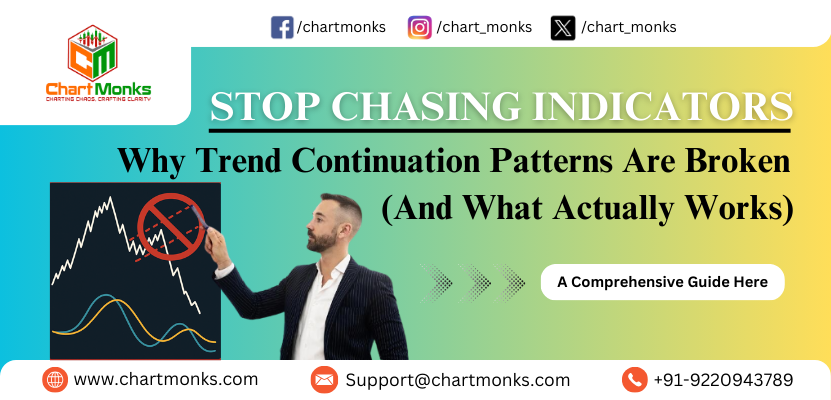Let’s cut through the noise. If you’re still obsessing over “trend continuation chart patterns” or chasing breakout strategies, you’re missing the point. The trading world is flooded with overcomplicated jargon, lagging indicators, and methods that promise profits but deliver frustration. At ChartMonks, we teach traders to step away from the herd mentality—because real edge lies in patience, not panic.
The Problem with Trend Continuation Patterns
“Best trend continuation chart patterns” are plastered all over trading forums and YouTube tutorials. Triangles, flags, pennants—traders are told to buy breakouts, ride momentum, and “follow the trend.” But here’s the truth: breakout trading is a trap for retail traders.
Why?
- False breakouts dominate: Markets fake direction shifts constantly. What looks like a bullish flag often reverses into a liquidity grab.
- You’re late to the party: By the time a “trend continuation pattern” forms, the smart money has already positioned itself. You’re entering when institutions are taking profits.
- Indicators lie: RSI, MACD, moving averages… these tools react to price, not predict it. Chasing them keeps you one step behind.
At ChartMonks, we don’t trade breakouts. We don’t gamble on current price action. Instead, we wait for the market to come to us.
Why the “Best Trend Continuation Chart Patterns” Are a Myth
Let’s get real: the internet is obsessed with labeling every squiggle on a chart as a “pattern.” But here’s what gurus won’t tell you:
- Patterns are hindsight bias: A “bullish flag” only looks obvious after the move. In real time, it’s just noise.
- They ignore context: A triangle pattern in an institutional supply zone is suicide. The same pattern in a demand zone? Maybe. But most traders don’t know the difference.
- Retail traders are the exit liquidity: When you buy a breakout, you’re often the fuel for institutional profits.
At ChartMonks, we don’t hate patterns—we hate how they’re misused. A chart pattern without institutional logic is astrology for traders.
The ChartMonks Method: Tracking Institutional Order Zones
Forget trend continuation chart patterns. Real trading is about institutional footprints, not retail patterns. Here’s how we do it:
- Identify Institutional Order Zones: We track levels where BIG financial institutions likely have pending orders—zones where banks, hedge funds, or market makers are forced to act. These are areas where liquidity clusters, stop hunts occur, or institutional accumulation/distribution happens.
- Wait for Price to Retrace to These Zones: Retail chases price. Institutions manipulate it. We wait for price to retrace to these order zones, whether it takes days, weeks, or months. This is where the real moves begin—not at breakout points.
- Trade the Institutional Playbook: Breakout traders get trapped. We trade where institutions must defend their positions. If a supply zone has pending sell orders from a bank’s OTC desk, price will react violently there—no “chart pattern” needed.
The Dirty Secret of “Trend Charts Patterns”
Ever wonder why most trading courses push “trend charts patterns” as holy grails?
- They’re easy to sell: Pretty lines and shapes make for great YouTube thumbnails.
- They keep you addicted: Lose money on a breakout? The guru tells you to “wait for the next pattern.”
- They ignore market mechanics: Institutions don’t care about your triangle. They care about order flow.
At ChartMonks, we teach you to see the market’s skeleton—not just its skin.
Why Breakout Strategies Fail (And Institutional Zones Work)
Let's say you spot a textbook "bullish flag" pattern forming after a strong uptrend. The crowd piles into the breakout, convinced it's their ticket to easy profits. But here's what really happens:
- The breakout triggers a flood of retail buy orders.
- Price surges briefly, hitting a hidden institutional supply zone.
- The "pattern" collapses as banks and hedge funds dump their positions into retail demand.
The Institutional Reality: Imagine a currency pair that's been rallying for weeks. Retail traders see a "perfect" flag pattern forming and prepare to buy the breakout at 1.2500. Meanwhile:
- Institutions have identified 1.2480 as a critical supply zone from previous institutional selling activity.
- They wait for retail traders to push price through the "pattern" breakout at 1.2500.
- As soon as breakout buyers commit, institutions start unloading positions at 1.2480.
- Price reverses sharply, trapping retail traders while institutions bank profits.
The brutal truth? That "bullish flag" was never real - it was just noise between institutional levels. The breakout was a liquidity grab, not a trend continuation.
How to Spot Institutional Order Zones (A Sneak Peek)
In our online trading course, we dive deep into tracking institutional footprints. Here’s a raw tip most won’t share:
- Look for “irregular” volume spikes: Sudden volume without price movement? That’s institutions loading orders.
- Ignore textbook levels: If everyone’s watching $50 as support, institutions will smash it. Focus on zones they need to defend.
- Timeframe stacking: Weekly zones matter more than daily. Monthly? Gold.
“Trend Continuation” Done Right: Follow the Institutions
When we teach “trend continuation charts patterns” in our online trading course, we redefine them. A trend isn’t about shapes—it’s about institutional intent:
- A rally starts when institutions finish accumulating in a demand zone.
- A drop starts when institutions trigger their supply zone orders.
If you’re trading a “continuation,” it’s only valid if price reacts to an institutional order zone. Otherwise, you’re gambling on retail noise.
Join the 5% Who Trade Like Institutions
Most traders fail because they follow the same retail playbook. At ChartMonks, our free trading course online teaches you to:
- Ignore chart patterns and track institutional order zones.
- Trade supply and demand levels where BIG money has to act.
- Leverage patience—not indicators—as your ultimate edge.
No-BS Trading Principles:
- “Best Trend Charts Patterns” mean nothing without institutional orders.
- “Trend charts patterns” are irrelevant without liquidity zones.
- Our “trading course online” is for traders ready to think like whales.
Stop Chasing. Start Seeing
The market rewards those who see what institutions hide. While others chase “trend continuation chart patterns,” we’ll teach you to trade the invisible levels that move markets.
Ready to unlearn everything? Join ChartMonks’ Trading Course Online No patterns. No indicators. Just institutional footprints and the discipline to follow them.




